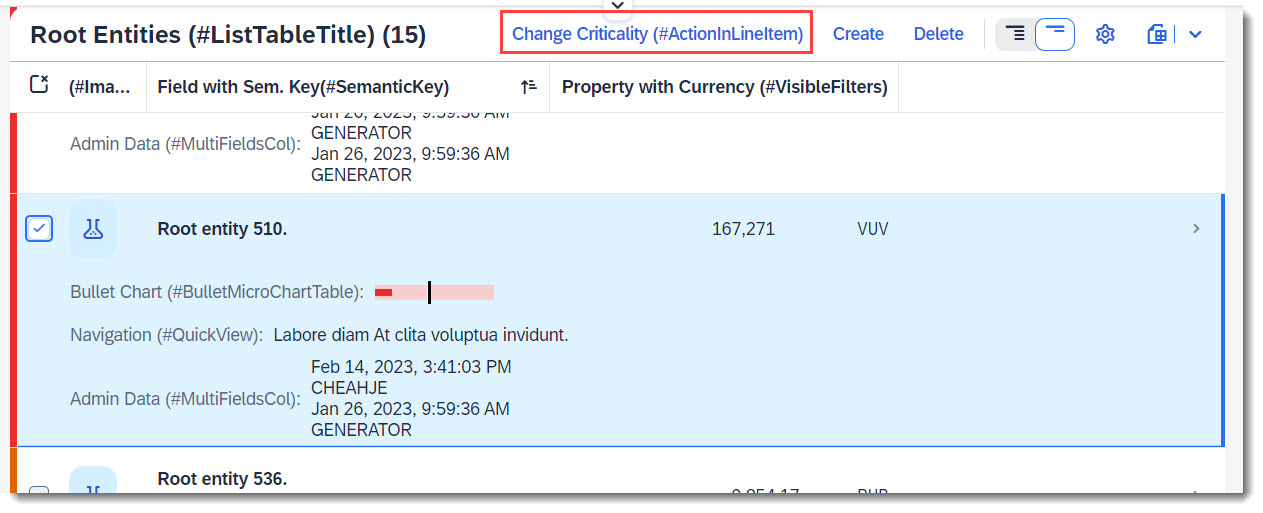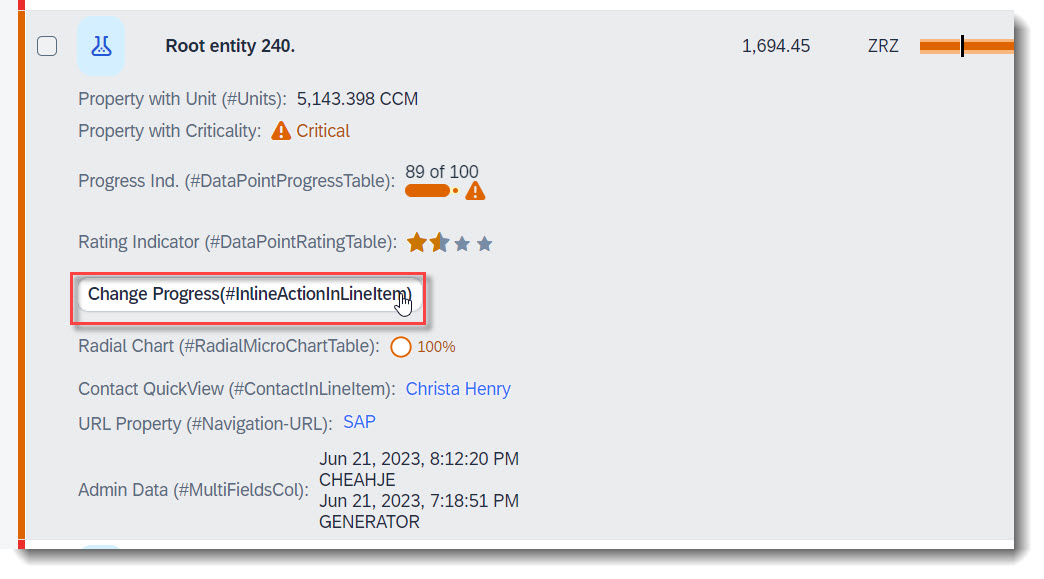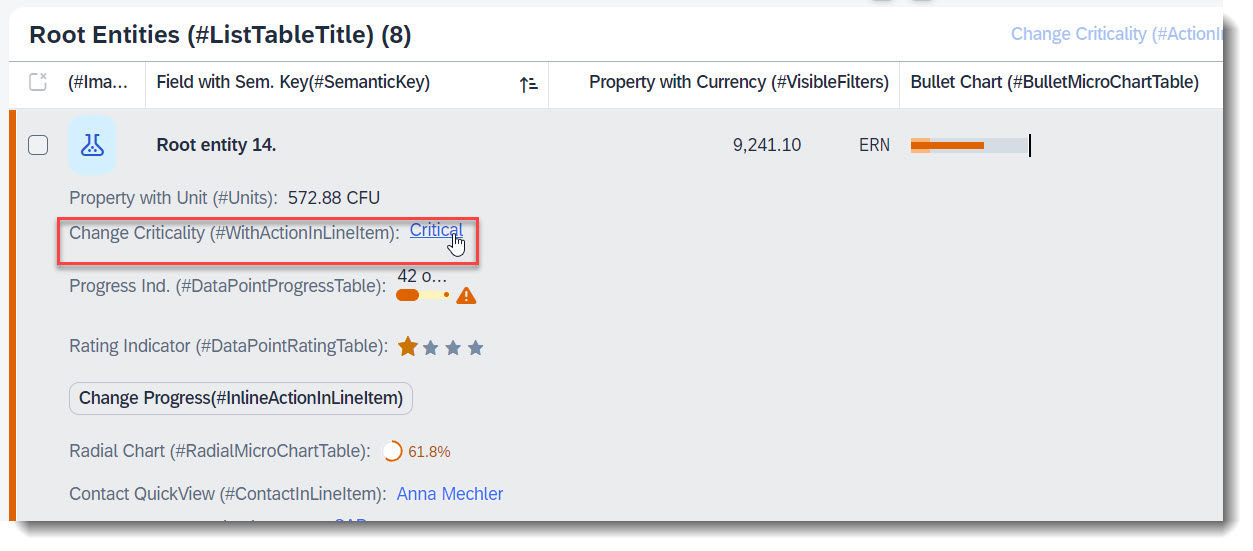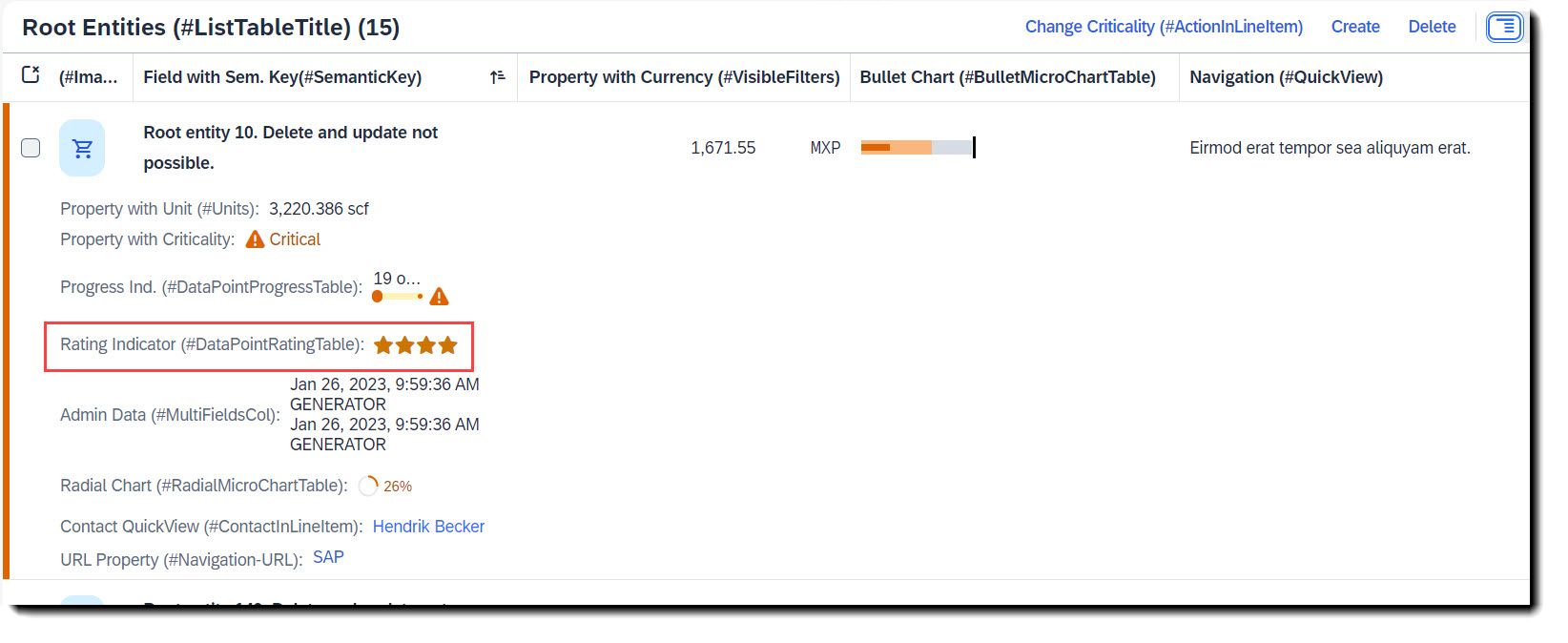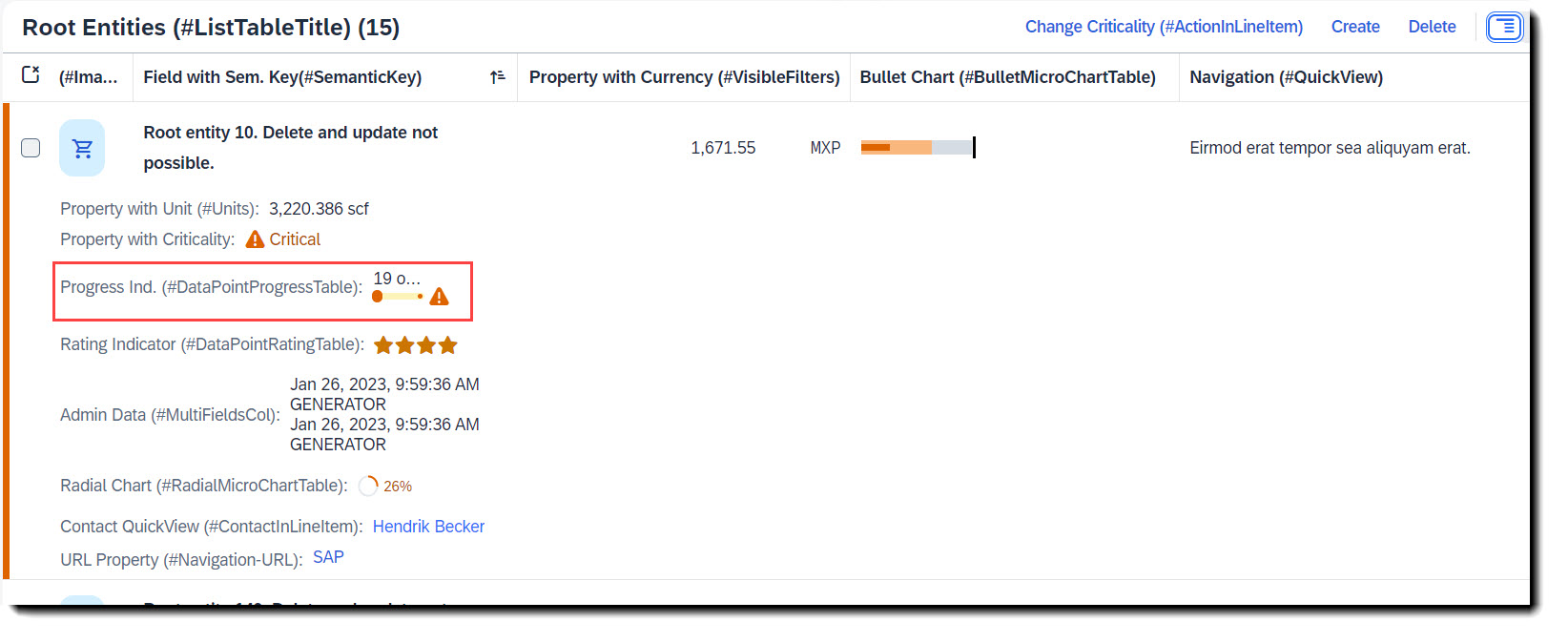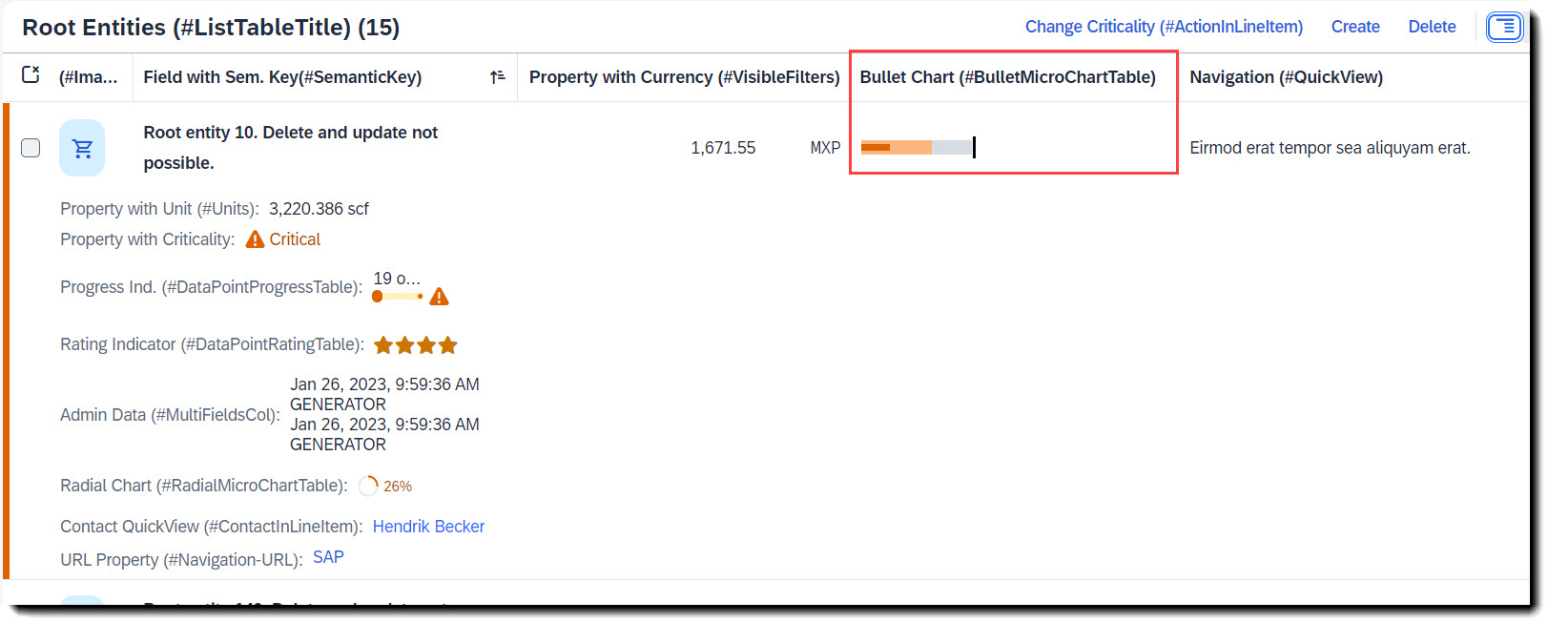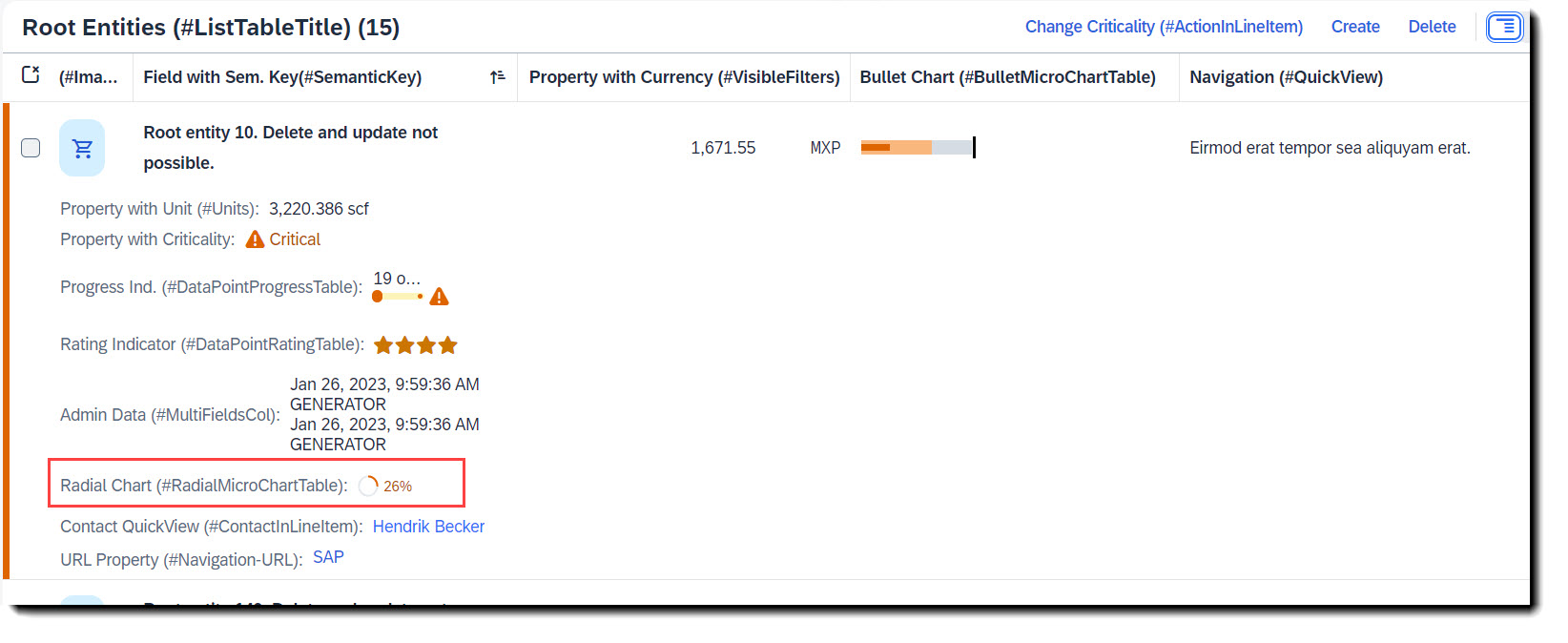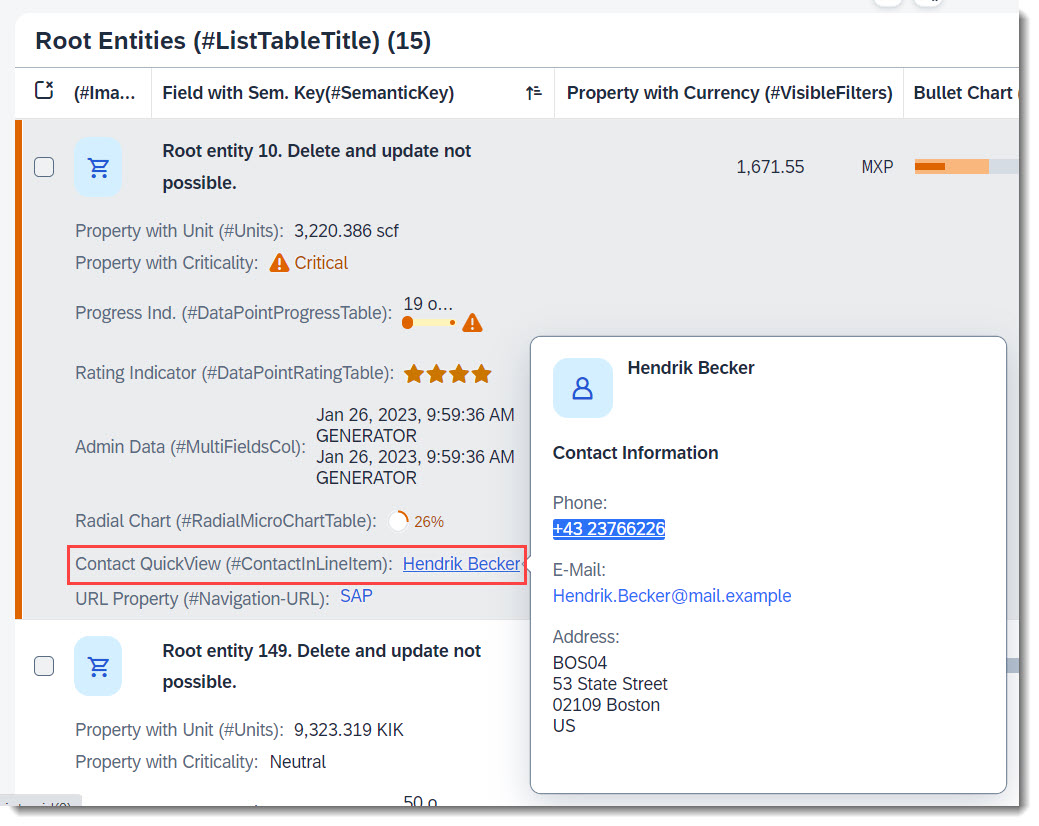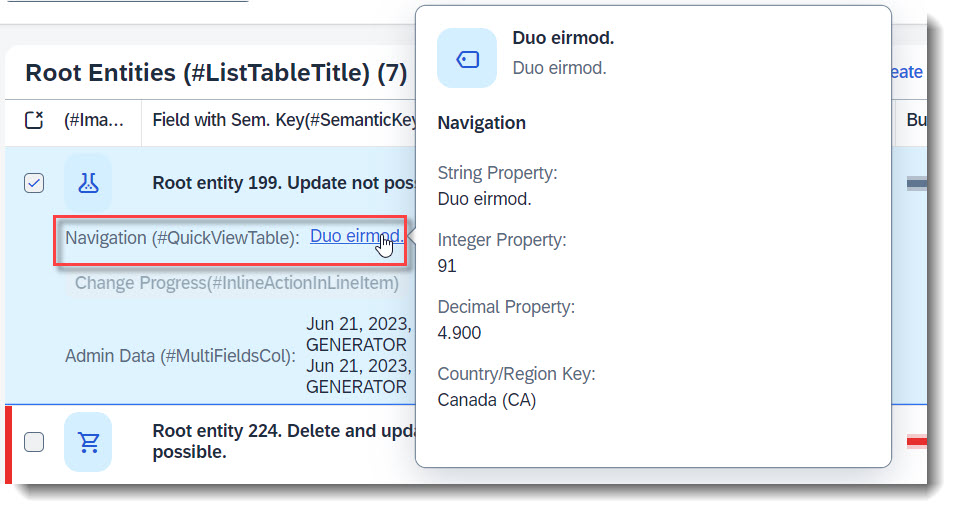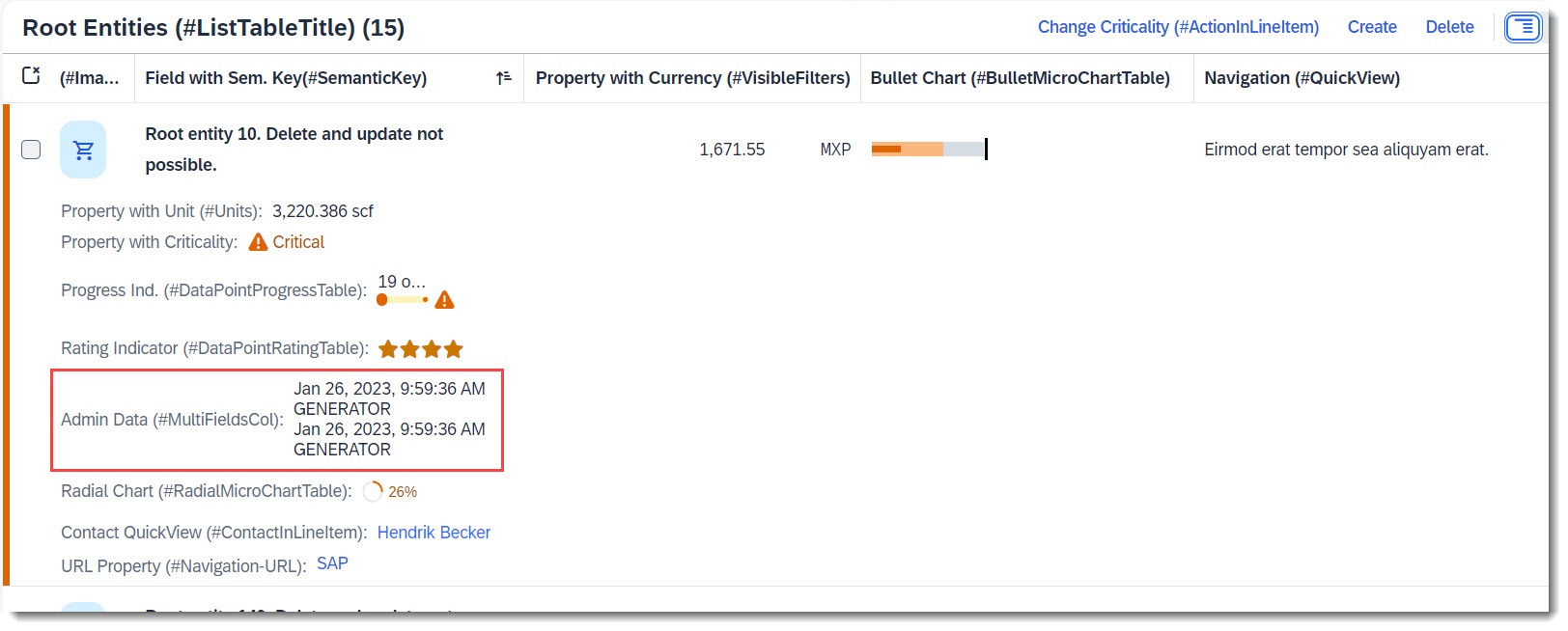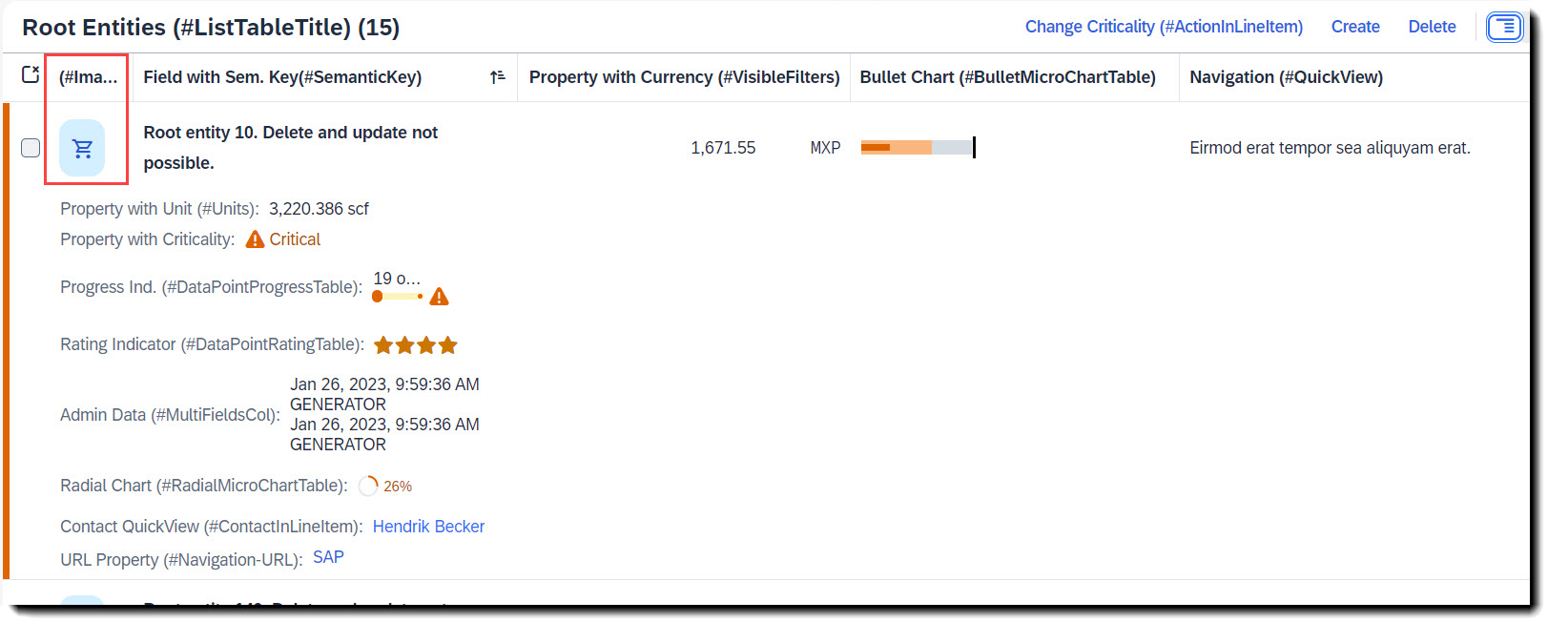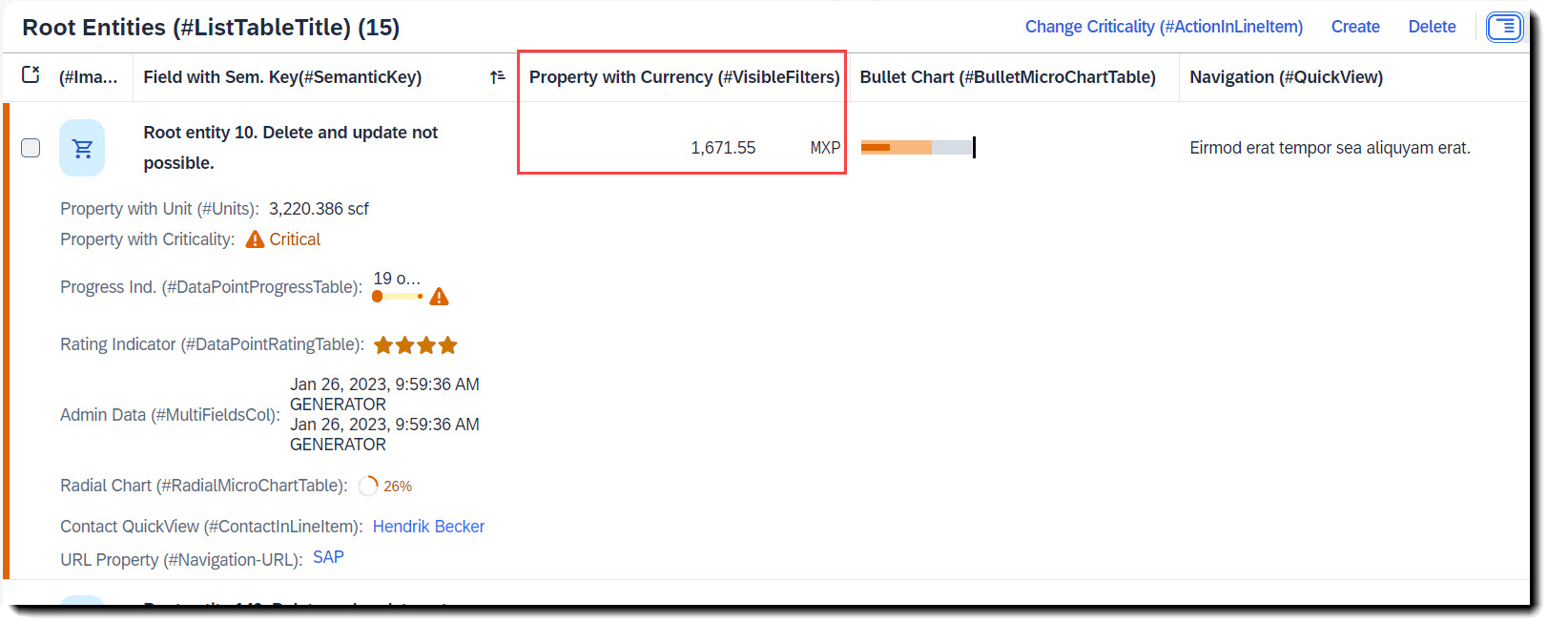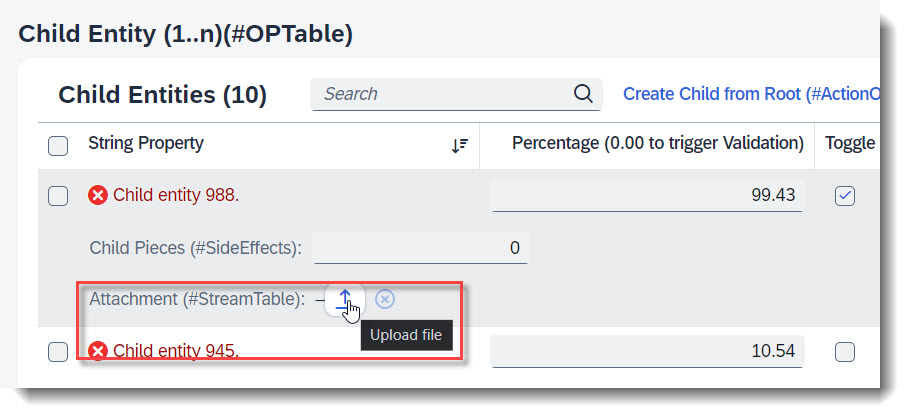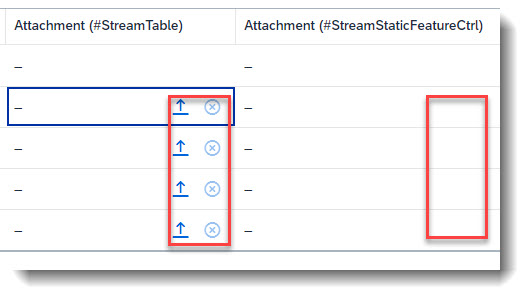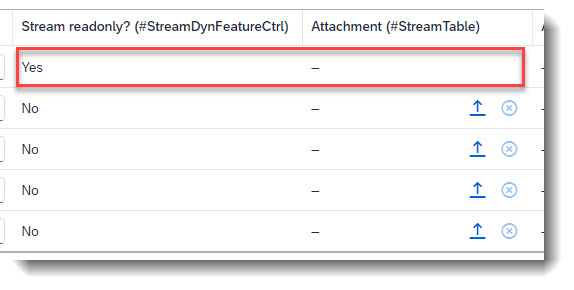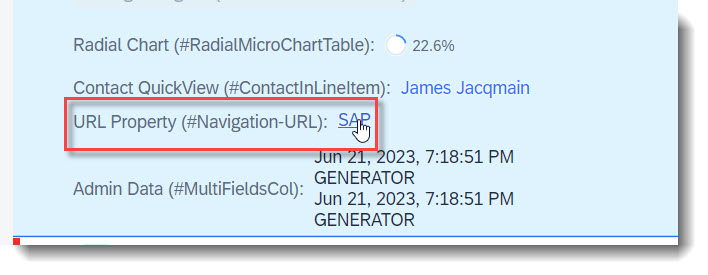- List Report - Content Area
- Configuring Tables
- Actions - List
- Presentation Variant - List Report
- Selection Variant - List Report
- Selection Presentation Variant - List Report
- Defining the Default Sort Order
- Highlighting Line Items Based on Criticality
- Adding a Rating Indicator to a Table
- Adding a Progress Indicator to a Table
- Adding a Smart Micro Chart to a Table
- Adding a Contact Quick View to a Table
- Adding a Quick View to a Table
- Adding Multiple Fields to one Column in a Table
- Adding Images to a Table
- Adding Currency or UoM Fields to a Table
- Adding Large Object/Stream Property to a Table
- Adding Navigation with URL to a Table
- Configuring Tables
To see columns in your table, you would first have to define them with the annotation @UI.lineItem at the property, either in the CDS view or in a metadata extension. The most basic setting you can use would be:
- the order of the column in the table and
- changing the column label, if you do not want to use the label from underlying views.
In the example below, StringProperty would be the second column in the table (the numbering used here is 10, 20, etc. You could also start with 1, 2, etc. ), defined using position. label would be the column label/heading.
importance denotes the importance of the property. With #HIGH, this means that the property will always be shown even if the table is rendered on a small display.
Note
Source: Metadata Extension /DMO/FSA_C_RootTP
@UI.lineItem: [
{
position: 20,
importance: #HIGH,
label: 'Field with Sem. Key(#SemanticKey)'
}
]
StringProperty;
More information: ABAP RESTful Application Programming Model - Tables
Search term: #ActionInLineItem
With this @UI.lineItem annotation, the action is displayed above the table on the right, with other possible actions.
Note
Source: Metadata Extension /DMO/FSA_C_RootTP
// Search Term #ActionInLineItem
@UI.lineItem: [
{
type:#FOR_ACTION,
label: 'Change Criticality (#ActionInLineItem)',
dataAction: 'changeCriticality',
position: 10
}
]
LastChangedAt;
Note
Source: Behaviour Definition /DMO/FSA_R_RootTP
action changeCriticality parameter /DMO/FSA_D_ChangeCriticalityP result [1] $self;
A regular action requires a line item to be selected before the button is activated but a static action is always active.
More information: ABAP RESTful Application Programming Model - Actions
Search term: #InlineActionInLineItem
Warning
Only available with the latest SAP BTP or SAP S/4HANA Cloud, public edition release and for SAP S/4HANA, on-premise edition or SAP S/4HANA Cloud, private edition, from release 2023 onwards.
Inline actions are used to trigger actions directly for a single line item. When declaring an inline action, the action button will show up in the table row within its own column.
The keyword to use for this is inline: true in @UI.lineItem, @UI.fieldGroup, etc in conjunction with an action.
Note
Source: Metadata Extension /DMO/FSA_C_RootTP
// Search Term #InlineActionInLineItem
@UI.lineItem: [
{
type:#FOR_ACTION,
label: 'Change Progress(#InlineActionInLineItem)',
dataAction: 'changeProgress',
inline: true,
emphasized: true,
importance: #HIGH,
position: 100
}
]
LastChangedAt;
Note
Source: Behaviour Definition /DMO/FSA_R_RootTP
action changeProgress parameter /DMO/FSA_D_ChangeProgressP result [1] $self;
Search term: #CopyActionInLineItem
Warning
Only available with the latest SAP BTP or SAP S/4HANA Cloud, public edition release and for SAP S/4HANA, on-premise edition or SAP S/4HANA Cloud, private edition, from release 2023 onwards.
For a deep copy of an instance, the RAP framework does not provide a copy action out of the box, unlike create/edit/delete. However you can define a factory action in the BDEF that copies an instance, and by using the keyword isCopyAction: true, the action button will be rendered in UI harmoniously with Create/Delete. When no label is provided, it is automatically set to 'Copy'.
The cardinality of a factory action is always [1], that means, only one instance can be copied at a time.
When used in conjunction with inline: true to render the Copy button at individual line items, a label must be provided by you.
Note
Source: Metadata Extension /DMO/FSA_C_RootTP
// Search Term #CopyActionInLineItem
@UI.lineItem: [
{
type:#FOR_ACTION,
dataAction: 'copyInstance',
isCopyAction: true
}
]
LastChangedAt;
Note
Source: Behaviour Definition /DMO/FSA_R_RootTP
factory action copyInstance [1];
Search term: #Navigation-IBN
An action navigating to a published app of an associated entity can be added, through Intent Based Navigation using @UI.lineItem. When the navigation is setup properly, a button will be rendered at the table toolbar. Since this feature requires Fiori Launchpad and a destination app that has been published, the following is just an example of how it can be coded, as this navigation does not work in a FE App Preview.
Here "FeatureShowcaseNavigation" is the semantic object to be referenced.
Note
Source: Metadata Extension /DMO/FSA_C_RootTP
// Search Tern #Navigation-IBN
@Consumption.semanticObject: 'FeatureShowcaseNavigation'
@UI.lineItem: [
{
label: 'IntentBased Navigation (#NavAction-IBN)',
type: #FOR_INTENT_BASED_NAVIGATION,
semanticObjectAction: 'manage',
requiresContext: true
}
]
NavigationID;
More information: ABAP RESTful Application Programming Model - Based on Intent
Search term: #WithActionInLineItem
Warning
Only available with the latest SAP BTP or SAP S/4HANA Cloud, public edition release and for SAP S/4HANA, on-premise edition or SAP S/4HANA Cloud, private edition, from release 2023 onwards.
An action that is tied to a data value, which would be rendered as a hyperlink. Therefore it is crucial to specify the annotation at the desired element which has the data value.
The keyword to use for this is type: #WITH_ACTION.
Note
Source: Metadata Extension /DMO/FSA_C_RootTP
@UI: {
lineItem: [
{
position: 50,
criticality: 'CriticalityCode',
label: 'Change Criticality (#WithActionInLineItem)',
type: #WITH_ACTION,
dataAction: 'changeCriticality',
importance: #LOW
}
]
}
FieldWithCriticality;
Note
Source: Behaviour Definition /DMO/FSA_R_RootTP
action changeCriticality parameter /DMO/FSA_D_ChangeCriticalityP result [1] $self;
Search term: #PresentationVariant
A presentation variant defines how the result of a queried collection of entities is shaped and how this result is displayed, for example as a list report or a chart (@UI.presentationVariant.visualizations), the sorting order (@UI.presentationVariant.sortOrder), or the number of items (@UI.presentationVariant.maxItems) to display per segment.
Note
Source: Metadata Extension /DMO/FSA_C_RootTP
// Search Term #PresentationVariant
@UI.presentationVariant: [
{
qualifier: 'pvariant',
maxItems: 5,
// Search Term #DefaultSort
sortOrder: [
{
by: 'StringProperty',
direction: #ASC
}
],
visualizations: [{type: #AS_LINEITEM}]
}
]
Search term: #SelectionVariant
With a selection variant, you can define how the properties of an entity set should be filtered. The attribute text of the annotation is the title of the view and the attribute filter contains all filter parameters.
Note
Source: Metadata Extension /DMO/FSA_C_RootTP
// Search Term #SelectionVariant
@UI.selectionVariant: [
{
qualifier: 'svariant',
text: 'Selection (Criticality between 0 and 2)',
filter: 'CriticalityCode GE 0 and CriticalityCode LE 2'
}
]
Search term: #SelectionPresentationVariant
A SelectionPresentationVariant bundles a Selection Variant and a Presentation Variant.
Note
Source: Metadata Extension /DMO/FSA_C_RootTP
@UI.presentationVariant: [
{
qualifier: 'pvariant',
maxItems: 5,
// Search Term #DefaultSort
sortOrder: [
{
by: 'StringProperty',
direction: #ASC
}
],
visualizations: [{type: #AS_LINEITEM}]
}
]
@UI.selectionVariant: [
{
qualifier: 'svariant',
text: 'Selection (Criticality between 0 and 2)',
filter: 'CriticalityCode GE 0 and CriticalityCode LE 2'
}
]
// Search Term #SelectionPresentationVariant
@UI.selectionPresentationVariant: [
{
text: 'SPresVariant (Criticality between 0 and 2)',
presentationVariantQualifier: 'pvariant',
selectionVariantQualifier: 'svariant'
}
]
Search term: #DefaultSort
Use the @UI.presentationVariant annotation to define a default sort order. The attribute by defines, on which property the sort order should be applied.
Without a sort order defined with direction, the values are ascending.
Note
Source: Metadata Extension /DMO/FSA_C_RootTP
@UI.presentationVariant: [
{
// Search Term #DefaultSort
sortOrder: [
{
by: 'StringProperty',
direction: #ASC
}
],
visualizations: [{type: #AS_LINEITEM}]
}
]
Search term: #LineItemHighlight
Line items can be highlighted based on criticality. The @UI.lineItem annotation should be annotated at Entity level.
Note
Source: Metadata Extension /DMO/FSA_C_RootTP
// Search Term #LineItemHighlight
@UI.lineItem: [{criticality: 'CriticalityCode'}] // Annotation, so that the line item row has a criticality
Search term: #DataPointRatingTable
To add a rating indicator (stars) to the table, you first need to define a datapoint with @UI.dataPoint. The property where datapoint is defined sets how many stars are visible. Values between x.25 and x.74 are displayed as a half star. The attribute targetValue defines how many stars are possible. Most importantly, the qualifier needs to match the property name.
To show it in the table, @UI.lineItem annotation is needed.
Note
Source: Metadata Extension /DMO/FSA_C_RootTP
@UI: {
// Search Term #DataPointRating, #DataPointRatingTable
dataPoint: {
qualifier: 'StarsValue',
targetValue: 4,
visualization: #RATING,
title: 'Rating Indicator (#DataPointRating)'
},
// Search Term #DataPointRatingTable
lineItem: [
{
type: #AS_DATAPOINT,
label: 'Rating Indicator (#DataPointRatingTable)',
importance: #LOW,
position: 70
}
]
}
StarsValue;
Example: ABAP RESTful Application Programming Model - Develop Node Extensions - Extension Node with Rating
Search term: #DataPointProgressTable
To add a progress indicator to the table, you first need to define a datapoint with @UI.dataPoint. The property where datapoint is defined sets the current progress and the attribute targetValue, the maximum progress. Additionally, a criticality can be given, if wanted. Most importantly, the qualifier needs to match the property name.
To show it in the table, @UI.lineItem annotation is needed.
Note
Source: Metadata Extension /DMO/FSA_C_RootTP
// Search Term #DataPointProgress, #DataPointProgressTable
@UI: {
dataPoint: {
qualifier: 'ProgressIntegerValue',
targetValue: 100,
visualization: #PROGRESS,
criticality: 'CriticalityCode',
title: 'Progress Indicator (#DataPointProgress)'
},
// Search Term #DataPointProgressTable
lineItem: [
{
type:#AS_DATAPOINT,
label: 'Progress Ind. (#DataPointProgressTable)',
importance: #LOW,
position: 60
}
]
}
ProgressIntegerValue;
Example: ABAP RESTful Application Programming Model - Develop Node Extensions - Extension Node with Progress
Search term: #BulletMicroChartTable
To add a bullet micro chart to a table you have to first define a data point at the property where the value is to be taken from, which is the actual bar. The following attributes are also mandatory: minimumValue to render the chart properly, forecastValue for the bar in the background with a lower opacity, targetValue (or targetValueElement) for the dark line and qualifier (qualifier must be set to the name of the property). Criticality is optional.
To show the chart, the property must then be annotated with @UI.lineItem.
Note
Source: Metadata Extension /DMO/FSA_C_RootTP
/// Search Term: #BulletMicroChart, #BulletMicroChartTable
@UI: {
dataPoint: {
qualifier: 'IntegerValue', //IntegerValue: horizontal bar in relation to the goal line
targetValueElement: 'TargetValue', //visual goal line in the UI
forecastValue: 'ForecastValue', //horizontal bar behind the value bar with, slightly larger with higher transparency
criticality: 'CriticalityCode',
minimumValue: 0 //Minimal value, needed for output rendering
},
// Search Term #BulletMicroChartTable
lineItem: [{
type:#AS_CHART,
label: 'Bullet Chart (#BulletMicroChartTable)',
valueQualifier: 'bulletChart',
importance: #HIGH,
position: 80
}]
}
IntegerValue;
The data point needs to be referenced in a @UI.chart annotation in the measure attributes. The chartType must have value #BULLET for a bullet chart, attributes measures and measureAttributes are mandatory.
// Search Term #BulletMicroChart, #BulletMicroChartTable
@UI.chart: [
{
qualifier: 'bulletChart',
title: 'Bullet Micro Chart (#BulletMicroChart)',
description: 'This is a micro chart',
chartType: #BULLET,
measures: ['IntegerValue'],
measureAttributes: [
{
measure: 'IntegerValue',
role: #AXIS_1,
asDataPoint: true
}
]
}
]
Search term: #RadialMicroChartTable
To add a radial micro chart to a table you have to first define a data point at the property where the value is to be taken from. The percentage value is the fraction of the property value and the target value, which is set in attribute targetValue (or targetValueElement). Both criticality and criticalityCalculation are supported, but if both are given criticality overrides criticalityCalculation. Qualifier must be set to the name of the property.
To show the chart, the property must then be annotated with @UI.lineItem.
Note
Source: Metadata Extension /DMO/FSA_C_RootTP
// Search Term #RadialMicroChart, #RadialMicroChartTable
@UI: {
dataPoint: {
qualifier: 'RadialIntegerValue',
targetValueElement: 'TargetValue', //The relation between the value and the target value will be displayed as a percentage
criticality: 'CriticalityCode'
},
// Search Term #RadialMicroChartTable
lineItem: [
{
type: #AS_CHART,
label: 'Radial Chart (#RadialMicroChartTable)',
valueQualifier: 'radialChart',
position: 110
}
]
}
RadialIntegerValue;
The data point needs to be referenced in a @UI.chart annotation in the measure attributes. The chartType must have value #Donut for a radial chart, attributes measures and measureAttributes are mandatory.
// Search Term #RadialMicroChart, #RadialMicroChartTable
@UI.chart: [
{
qualifier: 'radialChart',
title: 'Radial Micro Chart (#RadialMicroChart)',
description: 'This is a micro chart',
chartType: #DONUT,
measures: ['RadialIntegerValue'],
measureAttributes: [
{
measure: 'RadialIntegerValue',
role: #AXIS_1,
asDataPoint: true
}
]
}
]
Search term: #ContactInHeader, #ContactInLineItem, #Contact
To have a data field which shows a contact with a contact quick view, the contact quick view needs to be implemented first. An example would be:
Note
Source: CDS View /DMO/FSA_I_Contact
// Search Term #Contact
define view entity /DMO/FSA_I_Contact
{
@ObjectModel.text.element: ['Name'] // Search Term #DisplayTextAndID
key id as ID,
@Semantics.name.fullName: true
name as Name,
@Semantics.telephone.type: [#PREF]
phone as Phone,
@Semantics.address.country: true
country as Country,
@Semantics.address.street: true
street as Street,
@Semantics.address.city: true
city as City,
@Semantics.address.zipCode: true
postcode as Postcode,
@Semantics.address.label: true
address_label as AddressLabel
}
To show the contact card in the table you need to annotate the contact property with @UI.lineItem or if in a facet, with @UI.fieldGroup.
Note
Source: Metadata Extension /DMO/FSA_C_RootTP
@UI.facet: [
{
purpose : #HEADER, // or #STANDARD
label : 'General Data (#HeaderFieldGroup)',
type : #FIELDGROUP_REFERENCE,
targetQualifier: 'HeaderData'
}
]
// Search Term #ContactInHeader
@UI.fieldGroup: [
{
qualifier: 'HeaderData',
type: #AS_CONTACT,
label: 'Contact QuickView (#ContactInHeader)',
position: 70,
value: '_Contact'
}
]
// Search Term #ContactInLineItem
@UI.lineItem: [
{
type:#AS_CONTACT,
label: 'Contact QuickView (#ContactInLineItem)',
value: '_Contact',
position: 120
}
]
ContactID;
More Information: ABAP RESTful Application Programming Model - Contact Data
Search term: #QuickViewTable
Warning
Only available with the latest SAP BTP or SAP S/4HANA Cloud, public edition release and for SAP S/4HANA, on-premise edition or SAP S/4HANA Cloud, private edition, from release 2023 onwards.
A quick view is a pop up that shows more information, when you click on an entry in a column or an object page. Typically, it is used in combination with one-to-one or zero-to-one associations. By clicking on the link, more information about the associated entity can be displayed.
To set up an entity as QuickView, follow the steps here: Setting up QuickView
To show the QuickView in a table, just use annotation @UI.lineItem to add the property, with has referential constraint defined, into the table.
// Search Tern #QuickViewTable
@UI.lineItem: [
{
label: 'Navigation (#QuickViewTable)',
importance: #HIGH,
position: 90
}
]
NavigationID;
Search term: #MultiFieldsCol
Multiple fields can be shown in one column, if a field group is added to line item (with annotations @UI.lineItem and @UI.fieldGroup). First you must define the field group and secondly the line item.
Note
Source: Metadata Extension /DMO/FSA_C_RootTP
@UI.fieldGroup: [{ qualifier: 'AdminData' }] // Search Term #MultiFieldsCol
CreatedAt;
@UI.fieldGroup: [{ qualifier: 'AdminData' }] // Search Term #MultiFieldsCol
LocalLastChangedBy;
@UI.fieldGroup: [{ qualifier: 'AdminData' }] // Search Term #MultiFieldsCol
LocalLastChangedAt;
// Search Term #MultiFieldsCol
@UI: {
fieldGroup: [{ qualifier: 'AdminData' }],
lineItem: [
{
type: #AS_FIELDGROUP,
label: 'Admin Data (#MultiFieldsCol)',
valueQualifier: 'AdminData',
importance: #HIGH,
position: 100
}
]
}
CreatedBy;
Search term: #Image
Images are typically the first column in a table and help to visually guide the user. An image can be added to a table by just adding a normal property to the line items.
Note
Source: Metadata Extension /DMO/FSA_C_RootTP
// Search Term #Image
@UI.lineItem: [
{
cssDefault.width: '5em',
position: 10,
importance: #HIGH,
label: '(#Image)'
}
]
@EndUserText.quickInfo: '(#Image)'
ImageUrl;
The property which contains the image url has to, additionally, be annotated with @Semantics.imageURL: true.
Note
Source: CDS View /DMO/FSA_I_Root
@Semantics.imageUrl: true
image_url as ImageUrl,
Search term: #Units
The special thing about quantity or price properties, is that they have an additional property of unit/currency. The property containing the quantity/price should be linked with the property for unit/currency. For units of measure the annotation is @Semantic.quantity.unitOfMeasure and for currency, it is @Semantic.amount.currencyCode.
Note
Source: CDS View /DMO/FSA_I_Root
// Search Term #Units
@Semantics.quantity.unitOfMeasure: 'Uom'
field_with_quantity as FieldWithQuantity,
// Search Term #Units
@Semantics.amount.currencyCode: 'IsoCurrency'
field_with_price as FieldWithPrice,
More Information: ABAP RESTful Application Programming Model - Interaction with Other Annotations
Search term: #Stream, #StreamTable
You can enable your RAP application for maintaining large objects (LOBs). By doing so, you provide end users the option to incorporate external binary files or text files when editing entity instances. First the appropriate fields should be added into the database table and the CDS view, and also the annotations @Semantics.largeObject and @Semantics.mimeType. To show it in a table, you will need annotation @UI.lineItem. Lastly, you should also update the mapping and the draft table in your behaviour definition.
Note
Source: Database Table /DMO/FSA_ChildA
stream_filename : abap.char(128);
stream_mimetype : abap.char(128);
stream_file : abap.rawstring(0);
Note
Source: CDS View /DMO/FSA_C_ChildTP
StreamFilename, // Search Term #Stream
// Search Term #Stream
@Semantics.largeObject: {
acceptableMimeTypes: [ 'image/*', 'application/*' ],
cacheControl.maxAge: #MEDIUM,
contentDispositionPreference: #INLINE, // #ATTACHMENT - download as file
// #INLINE - open in new window
fileName: 'StreamFilename',
mimeType: 'StreamMimeType'
}
StreamFile,
// Search Term #Stream
@Semantics.mimeType: true
StreamMimeType,
Note
Source: Metadata Extension /DMO/FSA_C_ChildTP
// Search Term #Stream
@UI.hidden: true
StreamMimeType;
@UI.lineItem: [{ position: 40, label: 'Attachment (#StreamTable)' }] // Search Term #StreamTable
StreamFile;
// Search Term #Stream
@UI.hidden: true
StreamFilename;
Note
Source: BDEF /DMO/FSA_R_ROOTTP
define behavior for /DMO/FSA_R_ChildTP alias Child {
...
mapping for /dmo/fsa_child_a {
..
StreamFile = stream_file;
StreamFilename = stream_filename;
StreamMimeType = stream_mimetype;
}
More Information: ABAP RESTful Application Programming Model - Working with Large Objects
Search term: #StreamStaticFeatureCtrl
Warning
Only available with the latest SAP BTP or SAP S/4HANA Cloud, public edition release.
It is possible to enable static field control for your large object property/attachment. This is done by adding the control in the behaviour definition.
In our example, we have set the stream property to readonly.
Note
Source: CDS View /DMO/FSA_C_ChildTP
// Search Term #StreamStaticFeatureCtrl
@Semantics.largeObject: {
acceptableMimeTypes: [ 'image/*', 'application/*' ],
cacheControl.maxAge: #MEDIUM,
contentDispositionPreference: #ATTACHMENT , // #ATTACHMENT - download as file
// #INLINE - open in new window
fileName: 'StreamFilename',
mimeType: 'StreamMimeType'
}
StreamFileReadonly,
StreamFilename,
@Semantics.mimeType: true
StreamMimeType,
Note
Source: Metadata Extension /DMO/FSA_C_ChildTP
// Search Term #StreamStaticFeatureCtrl
@UI: {
lineItem: [
{
position: 70,
label: 'Attachment (#StreamStaticFeatureCtrl)'
}
]
}
StreamFileReadonly;
// Search Term #Stream
@UI.hidden: true
StreamMimeType;
// Search Term #Stream
@UI.hidden: true
StreamFilename;
Note
Source: BDEF /DMO/FSA_R_ROOTTP
define behavior for /DMO/FSA_R_ChildTP alias Child .. {
field ( readonly ) StreamFileReadonly; // Search Term #StreamStaticFeatureCtrl
}
More Information: ABAP RESTful Application Programming Model - Static Feature Control
Search term: #StreamDynamicFeatureCtrl
Warning
Only available with the latest SAP BTP or SAP S/4HANA Cloud, public edition release.
It is possible to enable dynamic field control for your large object property/attachment. This is done by adding the control in the behaviour definition.
In our example, we set the stream property to readonly, when the boolean property StreamIsReadOnly is set to true. This can only be done when creating a new child instance, as the property StreamIsReadOnly itself has field control readonly : update, mandatory : create.
Note
Source: Database Table /DMO/FSA_ChildA
stream_filename : abap.char(128);
stream_mimetype : abap.char(128);
stream_file : abap.rawstring(0);
stream_is_readonly : abap_boolean;
Note
Source: CDS View /DMO/FSA_C_ChildTP
StreamIsReadOnly, // Search Term #StreamDynamicFeatureCtrl
StreamFilename, // Search Term #Stream
// Search Term #Stream
@Semantics.largeObject: {
acceptableMimeTypes: [ 'image/*', 'application/*' ],
cacheControl.maxAge: #MEDIUM,
contentDispositionPreference: #INLINE, // #ATTACHMENT - download as file
// #INLINE - open in new window
fileName: 'StreamFilename',
mimeType: 'StreamMimeType'
}
StreamFile,
// Search Term #Stream
@Semantics.mimeType: true
StreamMimeType,
Note
Source: Metadata Extension /DMO/FSA_C_ChildTP
// Search Term #StreamDynamicFeatureCtrl
@UI: {
lineItem: [
{
position: 50,
label: 'Stream readonly? (#StreamDynFeatureCtrl)'
}
]
}
@EndUserText: {
label: 'Stream readonly? Caution - cannot be changed after create',
quickInfo: 'Stream readonly?'
}
StreamIsReadOnly;
// Search Term #Stream
@UI.hidden: true
StreamMimeType;
@UI: {
// Search Term #StreamTable
lineItem: [
{
position: 60,
label: 'Attachment (#StreamTable)'
}
]
}
StreamFile;
// Search Term #Stream
@UI.hidden: true
StreamFilename;
Note
Source: BDEF /DMO/FSA_R_ROOTTP
define behavior for /DMO/FSA_R_ChildTP alias Child ... {
field ( readonly : update, mandatory : create ) StreamIsReadOnly;
...
mapping for /dmo/fsa_child_a {
StreamFile = stream_file;
StreamFilename = stream_filename;
StreamMimeType = stream_mimetype;
}
}
Note
Source: Behaviour Implementation /DMO/FSA_BP_R_ROOTTP
CLASS lhc_child IMPLEMENTATION.
METHOD get_instance_features.
READ ENTITIES OF /DMO/FSA_R_RootTP IN LOCAL MODE
ENTITY Child
FIELDS ( StreamIsReadOnly )
WITH CORRESPONDING #( keys )
RESULT DATA(children).
result = VALUE #( FOR child IN children
( %tky = child-%tky
%field-StreamFile = COND #( WHEN child-StreamIsReadOnly = abap_true
THEN if_abap_behv=>fc-f-read_only
ELSE if_abap_behv=>fc-f-unrestricted )
) ).
ENDMETHOD.
ENDCLASS.
More Information: ABAP RESTful Application Programming Model - Dynamic Feature Control
Search term: #Navigation-URL
You can set the text of a property as a link to an external website using the annotation @UI.lineItem.type: #WITH_URL.
Note
Source: Metadata Extension /DMO/FSA_C_RootTP
// Search Term #Navigation-URL
@UI.lineItem: [
{
url: 'FieldWithUrl', //Target, when pressing the text
label: 'URL Property (#Navigation-URL)',
type: #WITH_URL,
importance: #MEDIUM,
position: 130
}
]
FieldWithUrlText;
More Information: ABAP RESTful Application Programming Model - With URL
